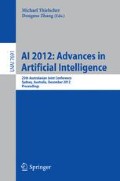Abstract
In this paper, we propose Rule Description Logic (RDL) for enhancing Description Logic (DL) with nonmonotonic recursive rules, like those in Answer Set Programming (ASP). We define the world view semantics for RDL and show that it is faithful with respect to both DL and ASP. More importantly, we show that the full language of RDL is decidable.
Access this chapter
Tax calculation will be finalised at checkout
Purchases are for personal use only
Preview
Unable to display preview. Download preview PDF.
References
Baader, F., Hollunder, B.: Embedding defaults into terminological knowledge representation formalisms. Journal of Automated Reasoning 14(1), 149–180 (1995)
Bonatti, P.A., Lutz, C., Wolter, F.: The complexity of circumscription in DLs. Journal of Artifical Intelligence Research 35, 717–773 (2009)
de Bruijn, J., Eiter, T., Polleres, A., Tompits, H.: Embedding non-ground logic programs into autoepistemic logic for knowledge-base combination. In: IJCAI, pp. 304–309 (2007)
Horrocks, I., Patel-Schneider, P.F., Bechhofer, S., Tsarkov, D.: OWL rules: A proposal and prototype implementation. Journal of Web Semantics 3(1), 23–40 (2005)
Grosof, B.N., Horrocks, I., Volz, R., Decker, S.: Description logic programs: combining logic programs with description logic. In: WWW, pp. 48–57 (2003)
Donini, F.M., Lenzerini, M., Nardi, D., Schaerf, A.: AL-log: Integrating datalog and description logics. Journal of Intelligent Information Systems 10(3), 227–252 (1998)
Motik, B., Rosati, R.: Reconciling description logics and rules. Journal of the ACM 57(5) (2010)
Rosati, R.: DL+log: Tight integration of description logics and disjunctive datalog. In: KR, pp. 68–78 (2006)
Eiter, T., Ianni, G., Lukasiewicz, T., Schindlauer, R., Tompits, H.: Combining answer set programming with description logics for the semantic web. Artifial Intelligence 172(12-13), 1495–1539 (2008)
de Bruijn, J., Pearce, D., Polleres, A., Valverde, A.: Quantified Equilibrium Logic and Hybrid Rules. In: Marchiori, M., Pan, J.Z., de Marie, C.S. (eds.) RR 2007. LNCS, vol. 4524, pp. 58–72. Springer, Heidelberg (2007)
Lukasiewicz, T.: A novel combination of answer set programming with description logics for the semantic web. IEEE Transactions on Knowledge and Data Engineering 22(11), 1577–1592 (2010)
Horrocks, I., Patel-Schneider, P.F., van Harmelen, F.: From SHIQ and RDF to OWL: the making of a web ontology language. J. Web Sem. 1(1), 7–26 (2003)
Gelfond, M., Lifschitz, V.: The stable model semantics for logic programming. In: ICLP 1988, pp. 1070–1080 (1988)
Lin, F., Zhou, Y.: From answer set logic programming to circumscription via logic of GK. Artifial Intelligence 175(1), 264–277 (2011)
Ferraris, P., Lee, J., Lifschitz, V.: Stable models and circumscription. Artifial Intelligence 175(1), 236–263 (2011)
Reiter, R.: A logic for default reasoning. Artifial Intelligence 13(1-2), 81–132 (1980)
Baader, F., Calvanese, D., McGuinness, D.L., Nardi, D., Patel-Schneider, P.F. (eds.): The Description Logic Handbook: Theory, Implementation, and Applications. Cambridge University Press (2003)
Gelfond, M.: Logic programming and reasoning with incomplete information. Annals of Maththematics and Artifial Intelligence 12(1-2), 89–116 (1994)
Lifschitz, V.: Minimal belief and negation as failure. Artifial Intelligence 70(1-2), 53–72 (1994)
Author information
Authors and Affiliations
Editor information
Editors and Affiliations
Rights and permissions
Copyright information
© 2012 Springer-Verlag Berlin Heidelberg
About this paper
Cite this paper
Zhou, Y., Zhang, Y. (2012). RDL: Enhancing Description Logic with Rules. In: Thielscher, M., Zhang, D. (eds) AI 2012: Advances in Artificial Intelligence. AI 2012. Lecture Notes in Computer Science(), vol 7691. Springer, Berlin, Heidelberg. https://doi.org/10.1007/978-3-642-35101-3_48
Download citation
DOI: https://doi.org/10.1007/978-3-642-35101-3_48
Publisher Name: Springer, Berlin, Heidelberg
Print ISBN: 978-3-642-35100-6
Online ISBN: 978-3-642-35101-3
eBook Packages: Computer ScienceComputer Science (R0)

